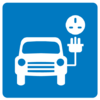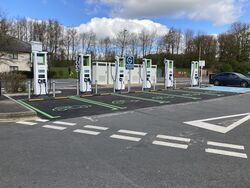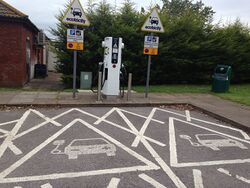Electric Vehicles
The overwhelming majority of service areas have electric vehicle charging points, and their provision is required of all new service areas and motorway truckstops. Previously these were all too few and not powerful enough, but this is less of an issue now, although some sites do still struggle to meet demand. Chargers are required to meet British accessibility standard PAS 1899, and service areas should identify space for future charging points.
The most common motorway charging point brand is the Electric Highway, which was acquired by GRIDSERVE. Moto are working on the basis that by 2030, 30% of their customers will be using electric vehicles; they have been politically active on the topic.
Meanwhile, big forecourt operators have been rolling out charging points under their own name, and this includes Applegreen, who are able to roll out rapid charging points at their Welcome Break motorway service areas. This could shake up the choice of motorway charging units, with Tesla Supercharger and IONITY also being introduced at some sites, alongside GRIDSERVE, leading to a variety of charging brand names being available at some sites. They generally charge inflated prices, a tradition led by motorway petrol stations.
The hurdle for motorway service areas continues to be the lack of charging capacity, with some sites having to decommission their charging points because they were taking power from the main facilities. This can be difficult to resolve as it involves many bodies working together. A related challenge is that a service area with a good power supply on one side of the road may not mean that the other side of the road can benefit, as utilities are banned from passing directly below or over a motorway.
Issues with a charging point should be sent to the charging point brand, who usually manage it on behalf of the operator. Note that while we try to stay up-to-date with regards to new installations and faults, we can only rely on the information we're given. As with fuel, motorway charging points sometimes charge higher fees than non-motorway sites, with fees being set by the charging brand depending on local factors. Complaints about ICE vehicles obstructing charging areas should be sent to the operator.
Motorway Charging Point Locator
You can use our search engine to detail all the charging points at official service areas on any selected road, or search by other criteria. This form will direct to the UK section.
Charging Point Brands
The names above outline the key players on the major road network, there are a number of different charging points provided at service areas. These include:
- Alfa Power
- Applegreen
- BP Pulse
- ChargePlace Scotland
- ecarNI
- ESB ecars
- EV On The Move is operated by EG On The Move
- Fuuse
- GeniePoint
- GRIDSERVE
- InstaVolt
- IONITY
- LiFe EV is operated by RAW Charging
- MFG EV Power
- Pod Point
- Shell Recharge
- Tesla Supercharger
- Westmorland Charging
This is not an exhaustive list of EV charging brands, only those at official service areas. This website is not in a position to advise on the merits of different charging brands.
Charging Point History


The UK service area regulations contained no reference to charging points until 2013, even though operators had been fitting them since 2007. Despite this, the 2013 update merely said that it encouraged operators to provide recharging facilities and alternative fuel technologies. This weak commitment received fawning media coverage.
At the same time the regulations were updated to acknowledge that there is an official symbol for electric vehicle charging points, and to advise that this can be used on motorway signs to advertise the facility. In most cases, this symbol is substituted for another food brand.
Providing an electric vehicle charging point finally became a mandatory obligation of motorway service areas in 2017. The announcement came with much government fanfare, even though just about every motorway service area already had one. In fact not only did most motorway service areas already have one, but Little Chef had already created a network of about 80 chargers which covered many major A-roads, and would go on to outlive their brand.
In March 2019, Highways England awarded BP Chargemaster and Swarco a £2.8million contract to install new charging points at public locations close to the major road network.
At the start of 2020, Roadchef, Welcome Break and BP were all quoted criticising the UK's electricity infrastructure, which they said was hindering their roll-out of charging facilities. During the case for Solihull services in December 2020, England's national highway authority requested a commitment to electric vehicles be agreed in writing; the first time this had happened.
What was called "Britain's first electric forecourt" opened in December 2020. GRIDSERVE at Braintree is effectively a normal major road service area, but with various types of electric charger instead of fuel pumps. With GRIDSERVE planning more sites, this is likely to encourage operators to step up a gear, and indeed MFG soon started building their own equivalents. For example at Colne Valley, Welcome Break have already committed to building 100 charging points (brand not known), way above the dozen-or-so that they usually provide.
Ecotricity formally sold their 'Electric Highway' network of motorway charging points to GRIDSERVE in June 2021. Ecotricity said the sale would allow GRIDSERVE to invest in the network, and to expand it in line with the government's expectations. GRIDSERVE had already been upgraded many of Ecotricity's chargers, and were now looking to refurbish the whole network. This process included working closely with Moto, who heralded the opening of their site at Rugby as being a landmark moment for electric vehicle charging.
Roadchef started adding canopies (or, "wet weather protection") to their new charging areas in 2022, saying it was a common request from customers.
In October 2023, it was reported that Moto were considering launching their own charging point brand. This could tidy up provision at their service areas, and bring them in line with Westmorland, Welcome Break (who use their parent company's brand) and the fuel providers. Meanwhile, Roadchef opened their first high-powered GRIDSERVE hub.
EG Group partnered with Tesla in November 2023, intending to roll out their 'EV Point' brand across ASDA Express sites.
With 56 chargers available by December 2023, Moto declared Exeter services to be the UK's biggest charging hub. It was overtaken by South Mimms in August 2024.
GRIDSERVE are now working on eHGV charging hubs at Tamworth, Exeter and most of the Extra service areas. With support from the government and fleet partners, there could be a network of eHGV charging hubs by 2030.
Government Intervention

In March 2021, Transport Minister Rachel Maclean told Electrifying.com that the British government would be spending nearly £1billion on improving the electric vehicle chargers on main roads. She said every motorway service area would have at least six rapid chargers by 2023, and that there would be 6,000 chargers across the major road network by 2030. These would be available to all road users with a contactless payment card, and the companies provided them would be contractually bound to provide a service that works at least 99% of the time, and to provide a 24 hour customer support line.
By June 2025, none of that money had been spent, and the Department for Transport (under a new government) said the money never existed. In the meantime, the industry had funded many of its own initiatives. The new government withdrew the commitment.
Although it wasn't stated explicitly, most electric vehicle drivers had interpreted the minister's announcement as an end to Ecotricity's dominance of the motorway network. She also suggested that the government's policy of allowing the private sector to decide what's needed hadn't worked, and that they now believe they have to intervene. Others had said the new fund would be biased towards motorway service areas.
Further Interventions
The UK's Competition and Markets Authority announced in July 2021 that they would be investigating the exclusivity arrangement between the Electric Highway and Moto, Roadchef and Extra. They also advised that the government's charger upgrade funding should only be provided on condition that motorists are offered more choice. This resulted in GRIDSERVE announcing that they would no longer enforce their exclusivity arrangements after 2026, and that they wouldn't take action against any rival charger funded via the Rapid Charging Fund.
A further intervention was announced in November 2021, when National Highways announced they would be investing £11million in energy storage systems, which would reinforce the electricity supply at up to 20 service areas that are experiencing issues with their energy connection.
The Department for Transport's new service area regulations, announced in 2022, contained many new rules about charging points, an outcome of the doomed funding scheme. Charging points are now mandatory at signposted A-road service areas and motorway truckstops.
The government rowed back on its enthusiasm for electric vehicles in September 2023, however Moto insisted it is business as usual, with them looking at options to expand charging capacity including building their own solar farms. They say they have had to hire 'bouncers' to deal with motorists who are frustrated by queues due to the lack of energy available. They continued to criticise the government's failure to provide enough power or use the funds it had allocated, pointing out that it could be nearly 2030 before a service area like Trowell gets the necessary grid connection.
Energy Storage Systems
National Highways, England's trunk road authority, announced they would be investing £8million in energy storage systems; giant battery packs inside air conditioned shipping containers that will be placed at motorway service areas where the electricity connection isn't currently good enough to supply the energy as it's demanded.
One of these units was made by British start-up Allye Energy, and is used to power the whole service area during times of high demand.

